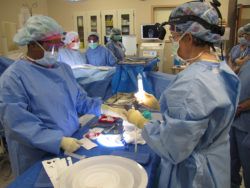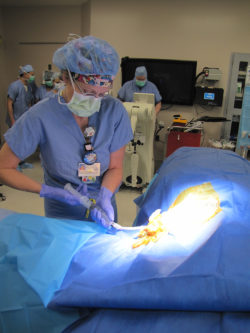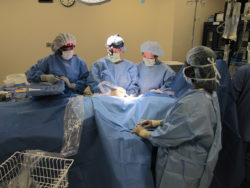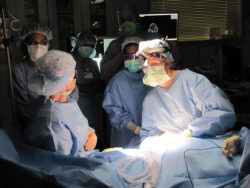One-Time Radiation Treatment for Breast Cancer Patients

New Procedure Reduces the Need for Weeks of Daily Breast Cancer Radiation
For some patients at Baptist Memorial Hospital for Women, there is a new way to get radiation therapy for breast cancer. The procedure, called intraoperative radiation therapy (IORT), delivers a concentrated dose of radiation during surgery to remove a tumor in the breast.
Dr. Alyssa Throckmorton, breast surgeon and medical director for Baptist’s multidisciplinary breast cancer program, said IORT helps reduce side effects, such as skin changes from whole breast radiation or risk of infection from partial breast radiation devices. IORT also eliminates the need for patients to make multiple trips to the hospital for weeks of radiation treatment.
“Patients can have their breast cancer removed, receive a single dose of radiation and be finished with all their local therapy in a single setting,” said Throckmorton.
A More Convenient Treatment Option
 Yavette Gray was one of the first patients in the operating room. Gray was diagnosed with an early form of invasive mammary carcinoma in December 2018. Initially, she opted to undergo a full mastectomy with reconstruction — a major surgery to remove her breast tissue.
Yavette Gray was one of the first patients in the operating room. Gray was diagnosed with an early form of invasive mammary carcinoma in December 2018. Initially, she opted to undergo a full mastectomy with reconstruction — a major surgery to remove her breast tissue.
“In the end, I reconsidered and decided to do a partial mastectomy with IORT,” said Gray. “Dr. Throckmorton explained why I was a candidate and that this procedure could allow me to get back to work and normal life sooner than traditional radiation treatments.”
Throckmorton performed three of the first four IORT procedures at Baptist Memorial Hospital for Women, and Dr. Lindi Vanderwalde performed the other procedure. In all cases, Dr. Angela Wortham, radiation oncologist, delivered the radiation once the area was prepped by the surgeon.
Potential candidates for IORT include patients who have:
- Early-stage breast cancer and are 45 years old or older
- Breast cancers that are estrogen receptor positive and negative for the HER2 gene
- Tumors that measure less than 3 centimeters and axillary lymph nodes that appear negative on preoperative examinations
Understanding the Procedure
Throckmorton and her team made sure Gray knew what to expect, from the first incision to how radiation would be delivered.
“First, we make an incision and remove the cancer from the breast,” said Throckmorton. “We put a balloon device in place where the cancerous tissue used to be. A radiation oncologist and a physicist bring in the machine that delivers the radiation. The radiation source slides down into the balloon and fills it. The process takes about 10 or 15 minutes.”
When the treatment is done, Throckmorton removes the balloon, closes the incision and sends the patient to the recovery room. Patients go home on the same day.
“Before IORT was available, patients like Yavette had the option of doing 20 treatments after surgery in a process similar to an X-ray,” said Throckmorton. “Alternately, patients could choose to do 10 treatments over a five-day period during which a temporary device is inserted into the breast and removed after treatment.”
IORT is a more convenient option. Gray, project manager for clinical trials at St. Jude Children’s Research Hospital, wanted to return to work without having to drive back and forth for multiple treatments.
“In Yavette’s case, we were able to finish all her treatment in one day — and she’s done really well,” said Throckmorton. “She’s cancer-free and didn’t need additional surgery or radiation treatment.”
Side Effects and Recovery
Gray credits her annual breast screenings for catching her cancer early.
“It’s really important to get your annual screening,” said Gray. “One of the reasons I was a candidate for this treatment is because they caught it so early. I would strongly encourage women to make sure they do self-examinations and never skip their annual screenings.”
Gray’s recovery period and side effects have been better than she anticipated. She manages her fatigue, soreness and discomfort with ibuprofen and rest. Throckmorton has not seen significantly more side effects with IORT. The risk for infection is lower than with other radiation treatments.
“It’s important to have the right team of medical professionals,” said Gray. “I was very pleased with Dr. Throckmorton — she was personable and down to earth. My joy and spiritual relationship with God also helped me emotionally. I’ve been fortunate to have my faith and the support of family and friends throughout this whole journey.”
Since Baptist began offering IORT, 24 patients have received the treatment and only two have needed to return for further treatment (whole breast irradiation).
Learn more about Baptist’s first intraoperative radiation therapy procedure, or explore programs and services at Baptist Memorial Hospital for Women. Find a doctor by visiting our Find a Doctor page.





